With the Stewart Hobbies’ (now Bowser) Baldwin DS-4-4-1000(606SC) and S-12 in HO scale, the possibilities for modeling the Valley’s Baldwin switchers have been expanded considerably. Some of the differences between the DS-4-4-1000 and S-12 are subtle, and Baldwin switchers generally changed a lot during their production runs, so that the LV units are likely to have some detail differences from any commercial model. This page covers the LV units to point out some of these areas. Please drop me a note if you can add anything!
The Valley Baldwin roster included:
| VO-1000 | 135 – 139 | Delivered 1944 in the Red & Gray paint scheme, all repainted into Cornell Red, and 137-139 repainted again into Tuscan before being scrapped or traded. All were gone by 1969. | HO: Stewart Hobbies’ 4730 (LV 316, Cornell Red/black stripes) or 4700 (undecorated) seems to be dead-on except for the exhaust stack. The LV units had a lower, wider stack with a lip around the top that is not clear in any photo I’ve seen. |
| DS-4-4-1000(606SC) | 140 – 148 | Delivered 1949 in the Cornell Red Scheme. All but 144 were repainted into Tuscan in the late 60s & early 70s, and all were scrapped or traded in by 1974. | HO: Stewart 4813 & 4814 (LV 140 & 148, Cornell Red/black stripes) or 4800 (undecorated). There are some differences in louvers and the sand filler cover between the model and the LV-owned units, which were early production. |
| DRS-4-4-15 | 200 | Delivered 1948 in Cornell Red, and used exclusively as a switcher after early road service proved unsatisfactory. Repainted into Tuscan in 1970, and traded in on GP38-2s in 1972. | HO: Stewart Hobbies’ AS-16 is a reasonable stand-in: 4150 (Cornell Red/black stripes, no numbers) or 4000 (undecorated). This was a late DRS-4-4-15, almost indistinguishable from an AS-16. To be exact, the radiator grill needs to be relocated to be flush with the walkway, and the middle horizontal bar removed. (The high vs. low position was not a distinguishing feature of DRS-4-4-15 vs AS-16.) See Lee Turner’s O scale model. |
| S-12 | 230 – 243 | Delivered 1950 in Cornell Red. 230, 232, 235, 237 & 241 were repainted into Tuscan in 1969-1972, and all scrapped or traded by 3/75. | HO: Stewart 4900 (undecorated) represents a later production S-12 than those delivered to the LV, so there are some detail differences.The 30+ year old Athearn is 6 scale inches short, and has the wide hood typical of early Athearn models. |
Differences between LV DS-4-4-1000s and S-12s
According to The Second Diesel Spotter’s Guide, the only visible difference is that some late DS-4-4-1000s and most S-12s had fabricated underframes, instead of the earlier combination cast & welded underframe. Since BLW’s production changes did not always coincide with model changes, and the frame construction was an option to be specified by the purchasing railroad, this is not a 100% reliable indicator.
Three louvers over the two access doors above the battery boxes appears to be a reliable DS-4-4-1000 spotting feature. An S-12 photo in The Second Diesel Spotter’s Guide shows only two louvers in this position, and photos of S-12s on the web seem to confirm this. Unfortunately, the number of louvers on the hood doors seems to vary according to railroad, or perhaps BLW production batch. BLW introduced many detail changes during DS-4-4-1000 production, and late production units may appear very similar to early production S-12s. Since it is the LV’s roster that concerns us here, I decided to concentrate only on what distinguishes the Valley’s Baldwin swithchers from each other. Where it is relevant, I’ve also pointed out features of the LV units that differed from the units owned by other railroads, and from available models.
I started by going to George Ellwood’s excellent Fallen Flags web site, and looking at his Lehigh Valley page. There is a series of DS-4-4-1000 and S-12 photos. Be careful to go by the road numbers, since George has some of the DS-4-4-1000s mislabeled as S-12s. In particular, look at the photos of DS-4-4-1000 #144 and S-12 #234. Both show the left side of the locomotives from a similar angle. Gary Stuebben, who contributed these photos by David Nyce, has given permission to use them here, so I’ve adjusted the contrast and brightness to show details more clearly, and cropped portions of these two photos to focus on the differences I found.

Most obviously, the LV’s DS-4-4-1000s had two windows in the cab above the hood. These are accurately reproduced in the Stewart model.

The S-12s had no window in this position. The Stewart model shows this correctly.
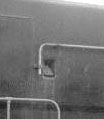
The hood-mounted handrail on LV’s DS-4-4-1000s turned down at the front, and curved in front of the sand filler. Stewart’s undecorated model has the correct shape handrail, but uses a later style flush mounted sand filler hatch like that found on LV’s S-12s. To be correct for the LV, the sand filler hatch should be recessed at an angle.
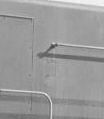
The handrail on LV’s S-12s was straight from front to back, and ended just above the sand filler hatch. The S-12 hatch has a flush fitting cover, like the later production DS-4-4-1000s. Stewart’s S-12 captures these details correctly for the LV units.
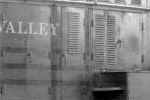
The LV’s DS-4-4-1000s had three sets of louvers on the doors on the left side of the hood. There were no door louvers on the right side of either loco. The left side photo of the undecorated model on Stewart’s web site shows NO door louvers. This was probably the only choice that was commercially feasible for a mass-production model, since presence or absence of door louvers, and their exact location, seems to vary in the DS-4-4-1000s on other railroads’ rosters.
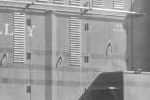
The LV’s S-12s had only two sets of door louvers, none in the same position as on the DS-4-4-1000! The Stewart S-12 model is correct for the LV units. The Athearn S-12 has one set of door louvers, but at least it is in one of the correct positions for a LV S-12. However, Athearn does not have the supercharger bulge in the hood which should be just aft of this set of louvers.

The DS-4-4-1000’s side frame member was thinner than that on the S-12, perhaps a reflection of the cast frame on the DS-4-4-1000.

The deeper side frame on the S-12 necessitated two access cutouts. The forward one appears to be for the fuel filler, and appears on both sides. According to Dave Forster, the rear cutout allows access to lubricate the truck bolster centercup, and there is a similar cutout on the right side of the front bolster. The two Stewart models capture these frame differences correctly.

The most subtle difference is the grouping of the louvers above the hood doors. There are 12 louvers on both the DS-4-4-1000 and the S-12, but they are grouped slightly differently. On the DS-4-4-1000, the louvers are spaced more (but not quite) evenly. The Stewart model captures this accurately.

On the S-12, there is a clear grouping of 1-2-2-2-3-1-1 from front to rear. The louver arrangement on both sides is the same on both locomotives. The Stewart S-12 has the correct louver arrangement, while Athearn’s S-12 is incorrect, with 14 louvers – they added a new group of 2 louvers in front of the group of 3.
I was unable to see any other frame differences in the photos on George’s site, but there were no good shots of the pilots, which is where Steve Stewart points out the frame features on the DS-4-4-1000 that his crew measured. I know I did not spot all the differences on the LV locomotives, but Norman Mueller has added a few. If you can add something that we’ve missed, send me a note.
– Ed
LV 137 (VO-1000), by Curt Pope
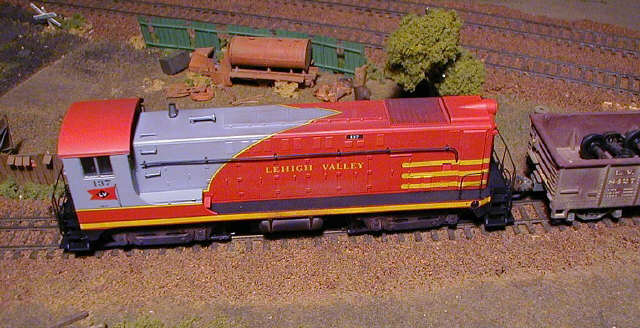
LV 200 (DRS-4-4-15), by Lee Turner
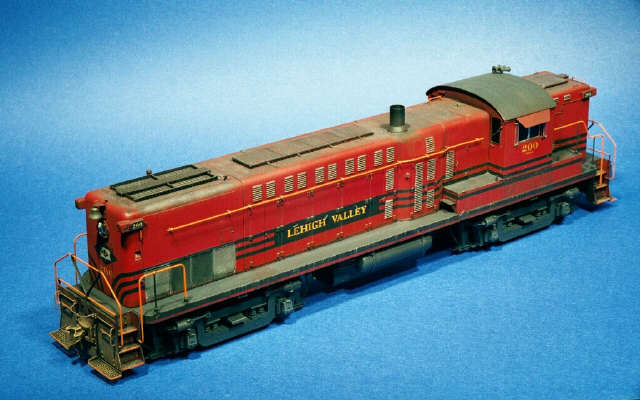
This O scale model “started out as a kitbash of the Mikes Train House Baldwin AS616 which I planned on repowering with a Weaver power train. After I purchased the model and sat it on the shelf something did not look quite right so I broke out the scale ruler and plans. To be kind I would probably say they took some artistic license when they made the tooling. I was already prepared to scratchbuild the short hood and radiator assembly but the cab was entirely wrong, the hood was 2 scale feet too tall and 1 foot too wide. The outcome of this was to scratchbuild everything but the louvers and hood doors on the long hood. This was extreme but I had to have a model of the 200 as it was my favorite Lehigh loco as I watched it many times in my childhood in Sayre.”
– Lee Turner